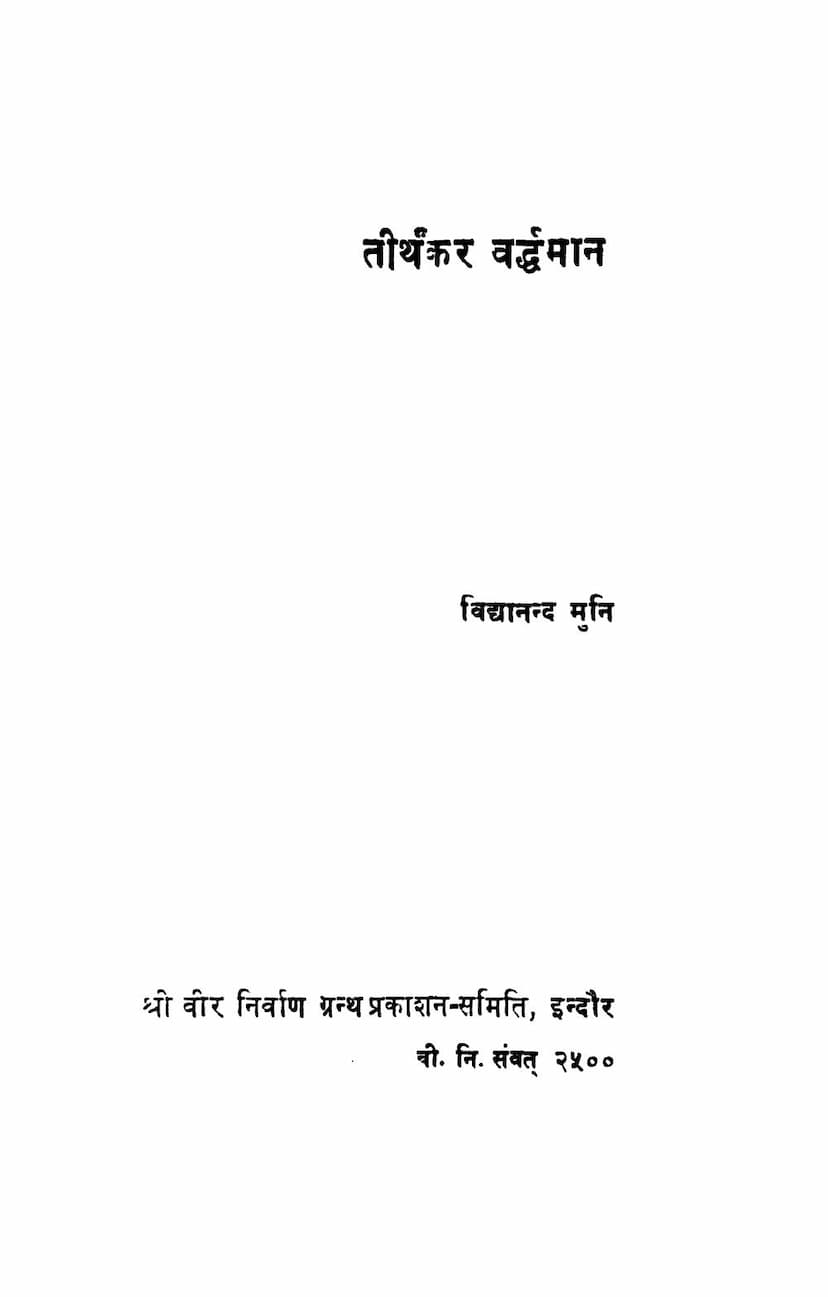Tirthankar Varddhaman
Added to library: September 2, 2025

Summary
Here's a comprehensive summary of the Jain text "Tirthankar Varddhaman" by Vidyanandmuni, based on the provided pages:
Book Title: Tirthankar Varddhaman Author: Vidyanandmuni Publisher: Shri Veer Nirvan Granth Prakashan Samiti, Indore
Overall Purpose and Nature of the Book:
This book is an enhanced and expanded edition of a previous work by Muni Vidyanandji titled "Veer Prabhu." Published in 1973 to commemorate the 2500th Veer Nirvana Mahotsava, it aims to present a scholarly and comprehensive account of the life and teachings of Lord Mahavir, the 24th Tirthankar. The book draws upon historical, astrological, cultural, and social perspectives, incorporating findings from recent research. It is written in Muni Vidyanandji's characteristic simple, accessible, and illustrative style, making complex Jain principles understandable.
Key Themes and Content:
-
Lord Mahavir's Life and Teachings: The book meticulously details Mahavir's life, from his birth and upbringing as Prince Varddhaman to his renunciation, rigorous asceticism, attainment of Kevala Jnana (omniscience), and his eventual Nirvana. It covers significant events, philosophical tenets, and the impact of his teachings.
-
Historical and Cultural Context:
- Varddhaman's Birthplace and Family: The text provides detailed information about Kundalpur (near Vaishali) as Mahavir's birthplace, his father Siddhartha and mother Trishala, and his maternal uncle Chetak, the ruler of Vaishali. It highlights Vaishali's advanced republican system, even when other nations were in their infancy.
- Mahavir's Era: The book situates Mahavir within the context of a turbulent India seeking peace. It emphasizes his role as a bringer of peace and a restorer of ancient principles of coexistence and religious tolerance.
- Jainism's Antiquity: The text asserts the ancient roots of Jainism, predating the arrival of Aryans, and highlights the influence of Jain philosophy and practices on broader Indian culture, including Vedic traditions. It notes the presence of Jain principles in texts like the Upanishads and mentions that Mahavir propagated his teachings in the common language.
-
Key Jain Philosophical Principles Explained:
- Ahimsa (Non-violence): Presented as the paramount principle, "Ahimsa Paramo Dharma," and its profound influence, even inspiring Mahatma Gandhi.
- Anekant (Multi-sidedness): Explained as the fundamental characteristic of reality, where each entity possesses infinite qualities and can be viewed from multiple perspectives. The book uses numerous examples (water, milk, Lord Rama, India's geography, finger lengths) to illustrate how different viewpoints, though seemingly contradictory, are all valid aspects of a single reality.
- Syadvada (Conditional Predication): Presented as the logical framework for expressing Anekant. It explains the "Syat" (kathyanchit/from a certain perspective) prefix to qualify statements, acknowledging that a statement is true only from a specific viewpoint. The book details the seven "bhangas" (modes of predication) that form the structure of Syadvada.
- Saptabhangi (Seven-fold Syllogism): The logical extension of Syadvada, outlining the seven ways a statement about reality can be constructed (is, is not, is and is not, is indescribable, is and is indescribable, is not and is indescribable, is and is not and is indescribable).
- Aparigraha (Non-possession) and Brahmacharya (Celibacy): Highlighted as core principles of Mahavir's ascetic practice.
-
Mahavir's Asceticism and Spiritual Attainment:
- Renunciation: Detailed account of Mahavir's detachment from worldly pleasures and his resolve to pursue spiritual liberation.
- Tapasya (Ascetic Practices): The book describes the extreme austerities Mahavir undertook, enduring harsh weather conditions, natural dangers, and even afflictions (uparg) from deities or demons without faltering in his meditation.
- Kevela Jnana (Omniscience): The process of shedding karmic impurities and attaining complete knowledge is explained, with the attainment occurring on the banks of the Rujukula river.
- Samavasharan: The description of the celestial assembly hall created by Indra for Mahavir's sermons, highlighting its intricate design and the inclusive seating arrangement for all beings.
- Maha-pariNirvana (Final Liberation): The account of Mahavir's passing in Pavapuri, the subsequent celebrations by gods and humans, and the lighting of lamps marking the beginning of Diwali.
-
Impact and Legacy:
- Vardhamana Names: Explains how he acquired names like Vardhaman (one who increases), Sanmati (one of true wisdom), Vir (hero), and Mahavir (great hero) due to his deeds and divine recognition.
- Influence on Society: The book emphasizes Mahavir's teachings brought about a shift in societal practices, particularly the condemnation of animal sacrifice and the promotion of compassion.
- Comparison with Buddha: A comparative section draws parallels between Lord Mahavir and Lord Buddha, noting their shared cultural milieu, noble birth, emphasis on self-discipline, and their respective contributions to spiritual thought in India.
- Vardhamana Nirvana Samvat: The establishment of the Jain era (Veer Nirvana Samvat) is noted as being 2500 years old in 1973, and its ancient origins are traced back to Mahavir's Nirvana.
- Names of Places: Mentions towns and regions named after Mahavir, such as Vardhaman, Birbhum, and Singhbhum.
Key Contributors and Acknowledged Sources:
- Publisher: Shri Veer Nirvan Granth Prakashan Samiti, Indore.
- Foreword: Written by Pandit Nathulalji Shastri, praising Muni Vidyanandji's scholarship and the book's significance.
- Cited Works: The text references various Jain scriptures, Puranas, and scholarly works, including the Bhagavata Purana, Mahabharata, Charaka Samhita, Chandogya Upanishad, Adi Purana, Harivansha Purana, Uttar Purana, Tirthankar Mahavir and Mahatma Gandhi, Jain Literature History, Mahavir Diary, and others.
Overall Message and Significance:
"Tirthankar Varddhaman" serves as a comprehensive and authoritative presentation of Lord Mahavir's life and the core Jain philosophical principles, particularly Anekant and Syadvada. It aims to educate readers about the antiquity and enduring relevance of Jainism, its ethical teachings, and its profound impact on Indian culture and philosophy. The book underscores the importance of these principles for contemporary society, promoting tolerance, non-violence, and rational inquiry.